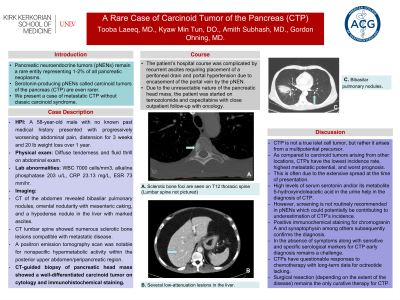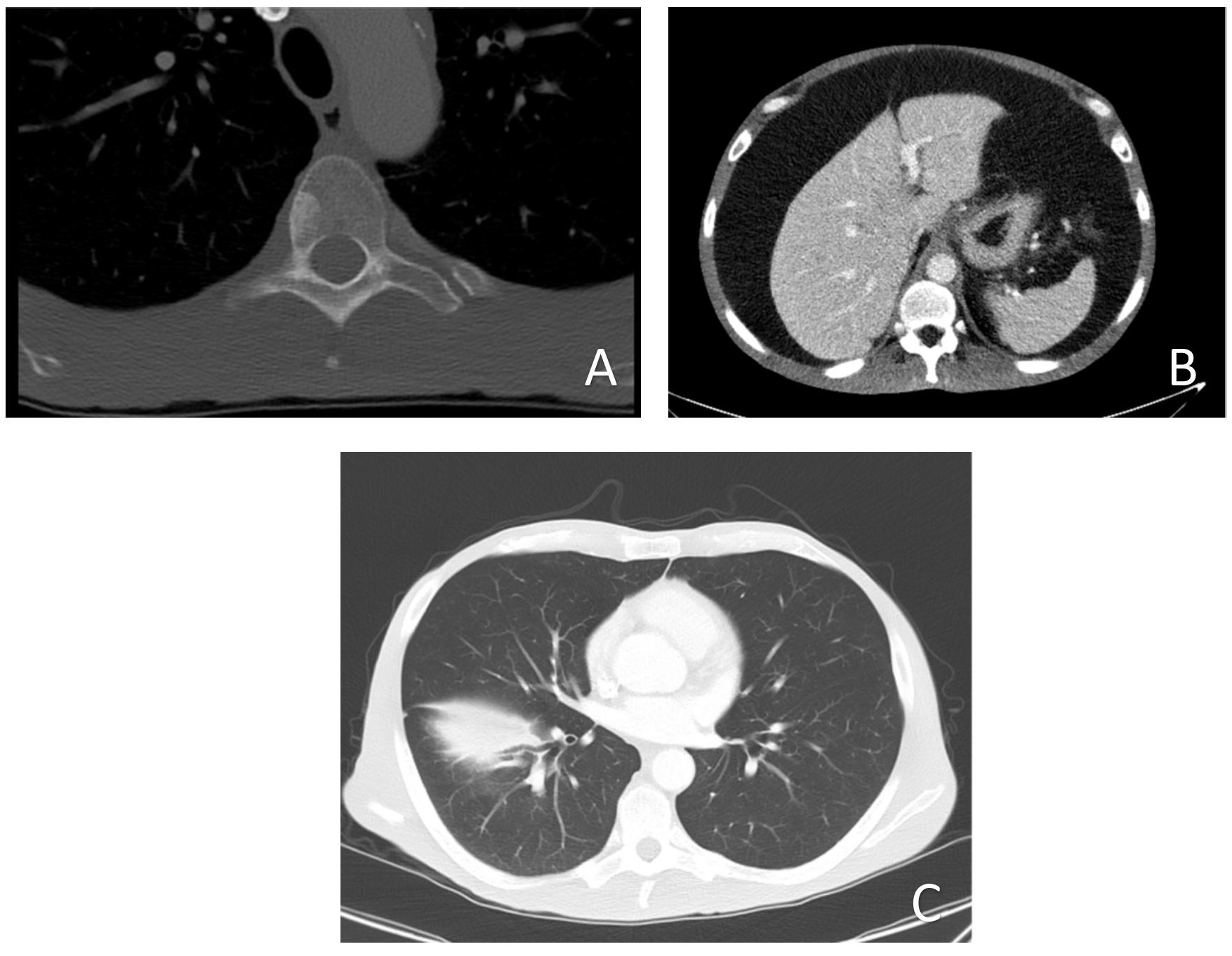Monday Poster Session
Category: Biliary/Pancreas
P1533 - A Rare Case of Carcinoid Tumor of the Pancreas (CTP)
Monday, October 23, 2023
10:30 AM - 4:15 PM PT
Location: Exhibit Hall

Has Audio

Tooba Laeeq, MD
University of Nevada, Las Vegas
Henderson, NV
Presenting Author(s)
Tooba Laeeq, MD1, Kyaw Min Tun, DO2, Amith Subhash, MD2
1University of Nevada, Las Vegas, Henderson, NV; 2Kirk Kerkorian School of Medicine at UNLV, Las Vegas, NV
Introduction: Pancreatic neuroendocrine tumors (pNENs) remain a rare entity representing 1-2% of all pancreatic neoplasms. Serotonin producing pNENs called carcinoid tumor of the pancreas (CTP) are even rarer. We present a case of metastatic CTP without classic carcinoid syndrome.
Case Description/Methods: A 58-year old male with no known past medical history presented with progressively worsening abdominal pain, distension for 3 weeks and 20 lb weight loss over 1 year. Physical exam revealed diffuse tenderness and fluid thrill on abdominal exam. Lab abnormalities included WBC 7000 cells/mm3, alkaline phosphatase 203 u/L, CRP 23.13 mg/L, ESR 73 mm/hr. CT of the abdomen revealed bibasilar pulmonary nodules, omental nodularity with mesenteric caking, and a hypodense nodule in the liver with marked ascites. CT lumbar spine showed numerous sclerotic bone lesions compatible with metastatic disease. Positron emission tomography scan was notable for nonspecific hypermetabolic activity within the posterior upper abdomen/peripancreatic region. CT-guided biopsy of pancreatic head mass showed well-differentiated carcinoid tumor on cytology and immunohistochemical staining. The patient’s hospital course was complicated by recurrent ascites requiring placement of a peritoneal drain and portal hypertension due to encasement of the portal vein by the pNEN. Due to the unresectable nature of the pancreatic head mass the patient was started on temozolomide and capecitabine with close outpatient follow-up with oncology.
Discussion: CTP is not a true islet cell tumor, but rather it arises from a multipotential precursor. As compared to carcinoid tumors arising from other locations, CTPs have the lowest incidence rate, highest metastatic potential and worst prognosis. This is often due to the extensive spread by the time of presentation. High levels of serum serotonin and/or its metabolite 5-hydroxyindoleacetic acid in the urine help in the diagnosis of CTP. However, screening is not routinely recommended in pNENs which could potentially be contributing towards underestimation of CTP’s incidence. Positive immunochemical staining for chromogranin A and synaptophysin among others subsequently confirm the diagnosis. In the absence of symptoms along with sensitive and specific serological markers for CTP early diagnosis remains a challenge. CTPs have questionable response to chemotherapy with long term data for octreotide lacking. Surgical resection (depending on the extent of disease) remains the only curative therapy for CTP.

Disclosures:
Tooba Laeeq, MD1, Kyaw Min Tun, DO2, Amith Subhash, MD2. P1533 - A Rare Case of Carcinoid Tumor of the Pancreas (CTP), ACG 2023 Annual Scientific Meeting Abstracts. Vancouver, BC, Canada: American College of Gastroenterology.
1University of Nevada, Las Vegas, Henderson, NV; 2Kirk Kerkorian School of Medicine at UNLV, Las Vegas, NV
Introduction: Pancreatic neuroendocrine tumors (pNENs) remain a rare entity representing 1-2% of all pancreatic neoplasms. Serotonin producing pNENs called carcinoid tumor of the pancreas (CTP) are even rarer. We present a case of metastatic CTP without classic carcinoid syndrome.
Case Description/Methods: A 58-year old male with no known past medical history presented with progressively worsening abdominal pain, distension for 3 weeks and 20 lb weight loss over 1 year. Physical exam revealed diffuse tenderness and fluid thrill on abdominal exam. Lab abnormalities included WBC 7000 cells/mm3, alkaline phosphatase 203 u/L, CRP 23.13 mg/L, ESR 73 mm/hr. CT of the abdomen revealed bibasilar pulmonary nodules, omental nodularity with mesenteric caking, and a hypodense nodule in the liver with marked ascites. CT lumbar spine showed numerous sclerotic bone lesions compatible with metastatic disease. Positron emission tomography scan was notable for nonspecific hypermetabolic activity within the posterior upper abdomen/peripancreatic region. CT-guided biopsy of pancreatic head mass showed well-differentiated carcinoid tumor on cytology and immunohistochemical staining. The patient’s hospital course was complicated by recurrent ascites requiring placement of a peritoneal drain and portal hypertension due to encasement of the portal vein by the pNEN. Due to the unresectable nature of the pancreatic head mass the patient was started on temozolomide and capecitabine with close outpatient follow-up with oncology.
Discussion: CTP is not a true islet cell tumor, but rather it arises from a multipotential precursor. As compared to carcinoid tumors arising from other locations, CTPs have the lowest incidence rate, highest metastatic potential and worst prognosis. This is often due to the extensive spread by the time of presentation. High levels of serum serotonin and/or its metabolite 5-hydroxyindoleacetic acid in the urine help in the diagnosis of CTP. However, screening is not routinely recommended in pNENs which could potentially be contributing towards underestimation of CTP’s incidence. Positive immunochemical staining for chromogranin A and synaptophysin among others subsequently confirm the diagnosis. In the absence of symptoms along with sensitive and specific serological markers for CTP early diagnosis remains a challenge. CTPs have questionable response to chemotherapy with long term data for octreotide lacking. Surgical resection (depending on the extent of disease) remains the only curative therapy for CTP.

Figure: A. Sclerotic bone foci are seen on T12 thoracic spine (Lumbar spine not pictured).
B. Several low-attenuations lesions in the liver.
C. Bibasilar pulmonary nodules.
B. Several low-attenuations lesions in the liver.
C. Bibasilar pulmonary nodules.
Disclosures:
Tooba Laeeq indicated no relevant financial relationships.
Kyaw Min Tun indicated no relevant financial relationships.
Amith Subhash indicated no relevant financial relationships.
Tooba Laeeq, MD1, Kyaw Min Tun, DO2, Amith Subhash, MD2. P1533 - A Rare Case of Carcinoid Tumor of the Pancreas (CTP), ACG 2023 Annual Scientific Meeting Abstracts. Vancouver, BC, Canada: American College of Gastroenterology.
